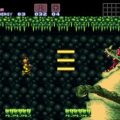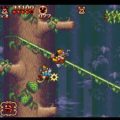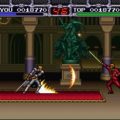Anytime a book about the 16-bit era is written a chapter needs to be written about Donkey Kong Country. Few games have had the impact that Donkey Kong Country had on its console generation. Not only did it help extend the SNES lifespan a few years it was also the game that pushed the SNES above the Genesis in America once and for all. Donkey Kong Country came with a lot of hype and while some of its perfect scores were not warranted it lived up to it. This is an excellent platformer and one of the SNES’ best games.
Bringing back Donkey for a new generation of gamers was not an easy task. Since he had only been in a few games the character was more or less a blank slate. It would have been easy to piggy back on the Mario characters but the developers took a different route. Rare created an entire mythos (that sounds so silly) around Donkey Kong and expanded his world. The groundwork laid here would serve as an excellent starting point towards giving Donkey Kong his own identity.
IT can’t be stated enough just how much preceded Donkey Kong Country’s release. It dazzled show goers at the Summer CES of 1994 but that was just the start. Nintendo sent out a videotape that went over the gameplay and process of creating the game to thousands of Nintendo Power subscribers in a genius bit or marketing. The practice had started a year before with Lords of Thunder but it really paid off here. Donkey Kong Country would go on to become the third best-selling SNES game of all time.
Donkey Kong is joined by his sidekick Diddy Kong for some two-player coop action. The differences between the two are slight but pronounced. Diddy is the faster of the two, able to jump higher and farther. But he is weaker, bouncing off stronger enemies or needing to perform specific attacks. Donkey Kong is the stronger, with the ability to ground slam in addition to rolling. The Kong’s function as a life bar; if you have both the inactive character becomes the focus if you take a hit.
If there is one thing Donkey Kong was famous for it was tossing barrels. Rare have incorporated barrels into nearly every facet of gameplay. There are a large variety of barrels for every occasion. DK barrels will contain your partner if they are lost. Regular barrels can be picked up and tossed while TNT barrels explode on impact. The rocket barrels are the most distinctive. Initially rocket barrels automatically send you flying in a given direction. But a few worlds in it escalates. Now you will have to manually release at the right time and it goes a step further with rotating barrels and needing to time it so that you land on an enemy to reach a platform. Barrel blasting was implemented as a way to get around the SNES limitations but is the game’s greatest strength.
While the level design is generally excellent it really is amazing just how clever the designers were in hiding secrets. Almost every level has two or three bonus areas and sometimes more. Some are in plain sight but many require a deft eye to spot or mastery of the game’s mechanics. The falling jump is a technique that shouldn’t work but is crucial in finding the game’s secrets, to say nothing of finishing the game. While the secrets are a nice bonus for gamers itching who want a 100% complete ratio they aren’t necessary. The game throws around bananas and extra lives like candy but with good reason.
Donkey Kong Country covers a lot of ground in its forty or so levels. There are about ten themes but Rare does a good job varying them up. When a theme is reused it is with a twist. Trik Trak Trek is the first level to take place on a moving walkway and is fairly simple. The second time, Tanked Up Trouble adds a new wrinkle, fuel. Your walkway uses gas and if you don’t keep it fueled it stops and drops. There are plenty examples like this, although they aren’t all as clever. While Donkey Kong Country may seem easy there is a reason you can wrack up extra lives early on. The late game has an unexpected difficulty spike. The good thing is it isn’t cheap; it is simply the game being confident that it has taught you its mechanics and no longer needs to hold your hand.
To say Donkey Kong Country was one of the best looking console games of 1994 is an understatement. There was simply nothing else like it, not even on the 3DO or Jaguar. The computer modeling technique Rare adapted to the SNES made DKC look like a next generation title. Say what you want about Rare’s character design but in terms of its background art DKC still looks amazing. The pre-rendered art hasn’t held up as well over the years but still looks better than most 16-bit titles. The backgrounds, with up to four or five layers of scrolling, still look fantastic and the animation is stellar. And it was graced with one of the best soundtracks of the era. Some aspects of the game may have been overrated but the presentation was not one of them.
In Closing
Donkey Kong Country is one of the best platformers of the 16-bit era. Don’t let anyone try and tell you otherwise. While there is a little bit of a backlash against the game that does not detract from the fact that it is still a generally excellent platformer. It did not revolutionize the genre but it never promised to. Enjoy DKC for what it is, a really good platformer in an era inundated with them.






5 thoughts on “Donkey Kong Country”